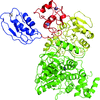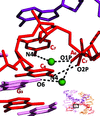issue contents
October 2012 issue

Cover illustration: Structure of d(CCGGGACCGG)4 as a four-way junction at 1.6 Å resolution ( Chakraborty et al., p. 1169).
structural communications
T. thermophilus enoyl-acyl carrier protein reductase was crystallized in the apo form, with NAD+ bound and with NAD+ and the inhibitor triclosan bound. The structures were solved by molecular replacement and refined at 1.50, 1.86 and 1.90 Å resolution, respectively. The structures are described, analysed and compared with those of enoyl-acyl carrier protein reductases from other species.
M. musculus and H. sapiens inositol monophosphatase 1 were cloned, expressed, purified and crystallized. Diffraction data were collected and analysed at resolutions of 2.4 and 1.7 Å, respectively, and the structures were compared in order to identify any structural differences.
The crystal structure of full-length HypF from T. kodakarenesis has been determined.
PDB reference: HypF, 4g9i
The structure of the HECT C-lobe of UBR5 shows a unique tertiary conformation. The sub-domain is also able to form a thioester bond with ubiquitin and may thus confer E2 binding specificity to UBR5.
PDB reference: C-terminal lobe of human UBR5 HECT domain, 3pt3
The crystal structure of AkMan, a gastropoda β-1,4-mannanase prepared from the common sea hare Aplysia kurodai, was determined at 1.05 Å resolution. This is the first report on the three-dimensional structure of gastropoda β-1,4-mannanase.
PDB reference: AkMan, 3vup
The crystal structure of a four-way DNA junction at 1.6 Å resolution provides new insights into solvent interactions and their implications.
PDB reference: d(CCGGGACCGG)4, 4ez2
The structure of the γ-aminobutyrate transaminase A1R958 from A. aurescens TC1 in complex with PLP–GABA reveals the active-site determinants of GABA binding in this enzyme.
crystallization communications
Two 30-amino-acid peptides derived from the two microtubule-binding tau protein regions have been cocrystallized with monoclonal antibody Fab fragments and preliminary X-ray diffraction analysis has been performed.
Crystals of the paired helical filaments (PHF) specific monoclonal antibody MN423 grown in the presence of two synthetic peptides derived from the PHF tau protein were analysed by X-ray techniques and the structure was solved by molecular replacement.
The exoglucanase CbsA from X. oryzae has been overexpressed, purified and crystallized. The crystal diffracted to a resolution of 1.86 Å.
The B. subtilis ribitol-5-phosphate cytidylyltransferase enzyme TarI was crystallized; determination of its structure will lead to structural and functional insight into the biosynthesis of wall teichoic acids.
This work describes the purification and preliminary crystallographic analysis of the CBS-domain pair of the murine CNNM2 magnesium transporter, which consists of a pair of cystathionine β-synthase (CBS) motifs and has 100% sequence identity to its human homologue.
Two protein tyrosine phosphatases, namely VcLMWPTP-1 and VcLMWPTP-2, from V. cholerae have been cloned, expressed, purified and crystallized.
The first crystallization of a fibrillar procollagen C-propeptide domain, that from human procollagen III, is described. Present throughout the Metaozoa in the form of ∼90 kDa trimers, this domain plays crucial roles in tissue homeostasis and disease.
MutT1 (MSMEG_2390) from M. smegmatis has been crystallized and preliminary X-ray studies of the crystals have been carried out.
The crystallization and initial diffraction analysis of human Drp1 GTPase-GED fusion protein are reported.
The P-III metalloproteinase from B. moojeni was crystallized and diffraction data were collected to a maximum resolution of 3.3 Å.
GIM-1 is a member of the class B carbapenemases and has a wide spectrum of activity against carbapenems, penicillins and extended-spectrum cephalosporins, but not aztreonam. In this study, GIM-1 was cloned, overexpressed and crystallized.
A phosphomimetic mutation in subunit ∊ dramatically increases reproducibility for crystallization of Escherichia coli ATP synthase catalytic complex (F1) (subunit composition α3β3γ∊). Diffraction data were collected to ∼3.15 Å resolution using synchrotron radiation.
The DrRecQ helicase catalytic core has been crystallized to a resolution of 2.9 Å. The determination of its structure will lead to structural and functional insight into the DNA repair mechanism.
The purification and crystallization of 3-quinuclidinone reductase from A. tumefaciens allowed the collection of a diffraction data set to 1.72 Å resolution.
A recombinant alanine racemase from the Pseudomonas putida YZ-26, has been crystallized by the sitting-drop vapor-diffusion method and X-ray diffraction data were collected to 2.4 Å.
The pH 6 antigen Psa displayed on the surface of Yersinia pestis, the bacterium that causes plague in humans, consists of polymers of a single protein subunit termed PsaA. Donor-strand complemented PsaA was purified and crystallized.
Crystals of S1-domain-truncated X. campestris PNPase were grown in the presence of c-di-GMP and diffracted to a resolution of 2.00 Å.
Kar9p from S. cerevisiae was cloned, overexpressed, purified and crystallized, and the crystals were characterized.
The outer membrane lipoprotein GumB from X. campestris was purified and crystallized by the hanging-drop vapour-diffusion method. A native data set was collected to a resolution of 2.54 Å.
A putative human D-xylulokinase enzyme has been expressed, purified and crystallized using a repetitive seeding protocol. The trigonal crystals belonged to space group P31 or P32, with unit-cell parameters a = b = 101.87, c = 158.85 Å, and diffracted X-rays to at least 2.7 Å resolution.
The RNA-dependent RNA polymerase of Thosea asigna virus has been purified and crystallized in two different crystal forms. Preliminary characterization of P21212 and C2221 crystals is reported. Co-crystallization experiments in the presence of lutetium produced a heavy-atom derivative suitable for structure determination.
Open  access
access
 access
accessCrystals of the portal protein from Staphylococcus epidermidis bacteriophage CNPH82, diffracting to ∼4.2 Å resolution, have been obtained. The protein is a 13-subunit oligomer both in solution and in the crystal.


 journal menu
journal menu








































![[publBio]](/logos/publbio.gif)





